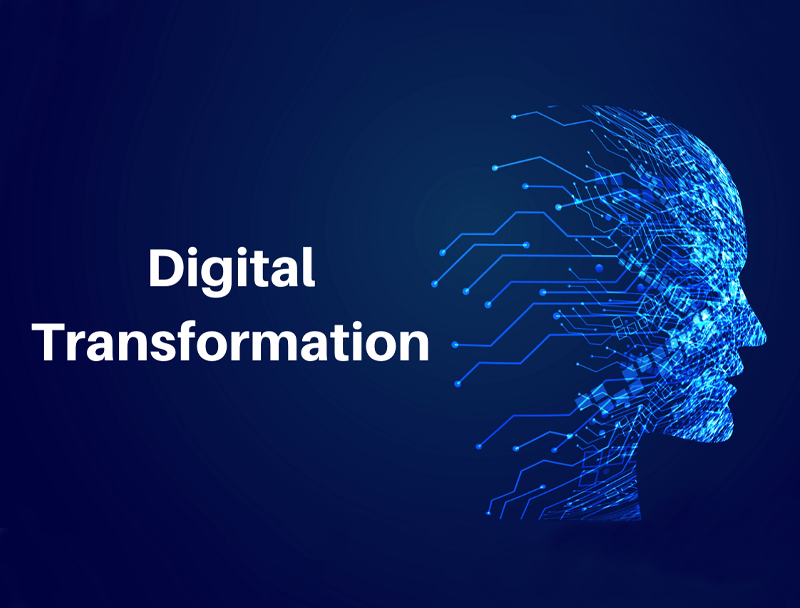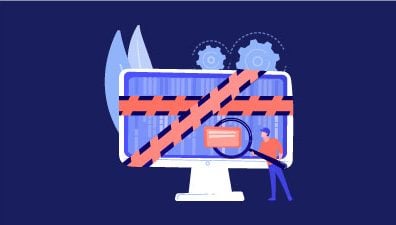In today’s hyper-competitive marketplace, differentiating yourself from the competition is essential for success, especially for small businesses. Almost any small business can benefit from digital transformation by leveraging technology to create unique customer experiences or developing innovative products and services. But what does that mean? And how can you get started with a digital transformation for small businesses?
In this post, we’ll define a digital transformation strategy for small business and give you some tips for making it work for your business. Plus, we’ll share a few examples of small businesses that have successfully undergone their own digital transformations. So read on to learn more!
Table of Contents
What is Digital Transformation for Small Business?

As the world becomes increasingly digitized, more and more businesses are looking to undergo digital transformation. This process is more than simply adding a few digital tools into current workflows – it requires a shift in mindset in regards to how the company functions now and it’s potential for operating better in the future.
Companies that successfully integrate digital technology into all areas of their businesses fundamentally change the way they deliver value and meet customer needs. In doing so, they gain a competitive advantage and position themselves for long-term success.
Best Examples of Digital transformation
As digital transformation increasingly becomes a top priority for businesses across industries, it’s helpful to look at examples of these tech trends in action
Uncorked by the Sea
Uncorked by the Sea is a wine and beer retail store that was established in Southport, North Carolina in 2011. The store has two employees and a digital order history function. Prior to the pandemic, the store’s business model was that customers come into the store, engage with the staff about preferences, taste a wine or two, select the wine(s), and complete the transaction. However, with the onset of the pandemic, Uncorked had to quickly adapt its business model to a digital one. The owners were pleasantly surprised to find an excellent order history function that allowed them to keep track of their customers’ preferences. As a result, they were able to provide personalized recommendations and ensure that their customers always had a satisfying experience. In addition, the shift to online sales has allowed Uncorked to reach a wider audience and continue to grow despite the challenges of the pandemic.
FreshBooks
FreshBooks is a cloud-based accounting software company that was founded in 2003 by Mike McDerment. The company provides small businesses with invoicing, expense tracking, and other accounting tools. FreshBooks was originally a PHP-based server-side app, but it was transformed into a client-side Ember platform app in 2017. The company’s goals are to help small businesses save time on accounting and to provide a convenient and professional way to manage client invoices. FreshBooks has been successful in achieving these goals, and it has become one of the leading accounting software companies in the world.
Brie’s Body Boutique
Brie’s Body Boutique (BBB) is a single-owner proprietorship in Philadelphia that sells all-natural products that promote healthy skin and hair. In response to the COVID-19 pandemic, BBB has decided to focus on improving its digital marketing in order to continue selling its products. One of the challenges that BBB faced was that its website was not very visually appealing and did not have an easy-to-use eCommerce store. However, with the help of a freeware tool, BBB was able to edit the backend HTML of its website and create a more visually appealing website with a simpler eCommerce store. Overall, by improving its digital marketing, BBB has been able to sell more products and reach a wider audience.
Why Small Businesses Need to Accelerate Their Digital Transformation
There are many reasons why small businesses need to digitize their operations, but perhaps the most important one is that it is essential for growth. In today’s economy, customers expect companies to be able to meet them where they are – and that means having a strong online presence. Companies that can’t keep up with this demand will quickly fall behind their competitors.
Moreover, the pandemic has forced many small businesses to give digitization a try and the results have been very promising. Small businesses that have embraced digital transformation are on an unprecedented upward growth path for the near future.

According to a study by Salesforce, only 1% of small businesses are in the “advanced” stages of digital transformation, while 41% are in the “early” stages and 58% have yet to start. The study also found that those who have digitized their operations are seeing significant benefits: companies in the advanced stages report average annual revenue growth of 28%, while those in the early stages report average annual revenue growth of 14%.
Fortunately, there are plenty of resources available to help small businesses digital transformation. There are numerous software programs and platforms that can help streamline operations and make it easier to connect with customers online. There are also many online courses and tutorials that can teach business owners the basics of digital marketing and web development. With that in mind, let’s look at some digital transformation trends that your business can follow in 2024.
Digital Transformation Trends To Follow In 2024
5G and IoT
The rollout of 5G networks and the proliferation of connected devices are two major trends that will continue to shape the digital transformation for small businesses in the coming years. Together, they will provide businesses with new opportunities to collect and analyze data, improve efficiency, and create new customer experiences. 5G networks are faster and more efficient than previous generations, and they will enable businesses to collect and analyze data in real-time. Connected devices, such as sensors and wearables, will generate a vast amount of data that can be used to improve business operations.

For example, retailers can use data from sensors to track inventory levels and optimize stock levels. Manufacturers can use data from wearables to improve worker safety and efficiency. Together, these two trends will create opportunities for businesses to become more data-driven and agile.
Zero-Trust Security
As the world increasingly moves online, businesses are following suit by migrating their data and applications to the cloud. While this shift provides many benefits, it also creates new security risks. In particular, businesses must now contend with cyber threats that can target any weak passwords, stolen credentials, and unpatched software vulnerabilities that can all lead to data breaches. As a result, businesses must adopt a zero-trust security model, which removes the assumption that all users are trusted by default. Under this approach, all users and devices must be authenticated and authorized before they are given access to sensitive data. This model has already been adopted by many large organizations, and it is quickly gaining popularity among small and medium-sized businesses. While zero-trust security can seem like a daunting task, it is essential for keeping businesses safe in the digital age.
Low-Code Platforms
In recent years, there has been a growing trend among businesses to move away from traditional coding skills in favor of low-code platforms. This approach allows businesses to develop custom applications without the need for extensive coding knowledge. Instead, businesses can use visual drag-and-drop tools to quickly build the applications they need. This approach is becoming increasingly popular as businesses look to speed up their digital transformation initiatives.
- Low-code platforms offer a number of advantages over traditional coding approaches.
- First, they allow businesses to develop applications much faster.
- Second, they require less technical expertise, making them ideal for business users who are not coders.
- Finally, low-code platforms are often more flexible and scalable than traditional coding approaches. As a result, they are well-suited for businesses that are looking to quickly develop custom applications.
Everything as a Service (XaaS)

The everything-as-a-service (XaaS) model is rapidly gaining popularity among small businesses digital transformation or even businesses of all sizes. XaaS provides a comprehensive, cloud-based solution for all of a business’s software and infrastructure needs. This allows businesses to focus on their core competencies, rather than having to manage complex IT systems. In addition, XaaS can help businesses save money by reducing the need for costly hardware and software licenses. As the demand for XaaS increases, more providers are entering the market, offering businesses more choice and flexibility. The XaaS model is here to stay, and it is only going to become more popular in the years to come.
Generative AI
Generative AI is a type of artificial intelligence that focuses on generating new content, rather than simply understanding or responding to existing data. This technology is still in its early stages, but it has the potential to revolutionize many industries by creating entirely new forms of data.
For example, generative AI could be used to create realistic 3D images or realistic audio recordings. In the future, this technology could also be used to generate new drugs or create new materials with unique properties. Generative AI represents a major shift in the way that artificial intelligence is used, and it has the potential to change the world in ways that we cannot even imagine.
Software 2.0
As the world becomes increasingly digitized, the role of software has become more important than ever. Today, the software is used to power everything from retail websites to self-driving cars. However, the current generation of software development is slow, expensive, and error-prone. This is where Software 2.0 comes in. Powered by artificial intelligence and other emerging technologies, Software 2.0 promises to dramatically improve the efficiency and quality of software development. This will make it more accessible to businesses of all sizes, which is good news for the economy as a whole.

In addition, this approach will help to create new jobs in the software development sector. So far, Software 2.0 has been successfully implemented by a few leading companies, and it is only a matter of time before it becomes the standard approach to software development.
RPA (Robotic Process Automation)
Robotic process automation (RPA) is a form of artificial intelligence that automates repetitive tasks. This technology is becoming increasingly popular as businesses look for ways to improve efficiency and reduce costs. RPA bots can be configured to handle a wide variety of tasks, from data entry and application processing to customer service and order fulfillment. In many cases, RPA can eliminate the need for human intervention, saving businesses time and money.
Additionally, RPA can help to improve the accuracy of data entry and reduce the risk of human error. As RPA technology continues to evolve, more businesses will likely adopt this cost-effective solution to automate their operations.
Keys to Digital Transformation Strategy for Small Businesses
Identify areas of your business that requires digitization improvements
As a business owner, you are likely facing a variety of pressing issues at the moment. For example, you may be concerned about how to keep your staff productive while they are working from home. Alternatively, you may be struggling to adapt to the new reality of remote work. However, it is important to remember that you are not alone in facing these challenges. By taking the time to list all of the pressing issues that you are currently facing, you can begin to develop a plan for addressing them. In addition, by identifying your short, mid, and long-term priorities, you can ensure that your business remains on track during these challenging times.
Think long term and plan for it
Digital transformation is an essential part of any business’s long-term planning. As technology advances, businesses must adapt in order to remain competitive. By looking toward the future and drafting long-term plans, businesses can ensure that they are taking advantage of new opportunities as they arise. When considering a digital transformation strategy, businesses should consider their growth rate and how they expect to grow in the coming years. By doing so, they can ensure that their strategy is aligned with their long-term goals and objectives. By taking the time to plan ahead, businesses can set themselves up for success well into the future.
Empower Employees With Data
Data is the key to driving accurate business decisions. You need to focus on using technologies that allow your team to extract value and insights from various datasets. Today, you can leverage a variety of affordable data collection and processing tools. They extract insights from data and share analytics across the company to aid real-time decision-making.
In addition, AI-driven technologies, such as machine learning, will be used widely for processing and analyzing a large amount of data. Investing in these tools strategically can help you make effective data-driven decisions that can improve your bottom line. With the right data, you can make informed decisions about where to allocate your resources and how to best serve your customers. so don’t delay in collecting and utilizing data to its fullest potential.
Ensure Seamless Integration of Business Systems
When digital transformation is done right, businesses can expect to see a significant improvement in various areas. Most initiatives aim to streamline operations, automate workflows, increase efficiency, and improve the customer experience. In order to achieve these goals, it’s important that all your business systems are communicating with each other seamlessly.
In the past, this was often difficult and expensive for small businesses to achieve. However, today’s cloud computing solutions are making it much easier and more affordable for small business digital transformation. Plus, it’s much easier to integrate different applications when they’re all in the same environment. As a result, businesses can expect to see improved workflow and greater efficiency.
Partner with the SMB Experience technology & service partners
When it comes to digital transformation for small businesses, finding the right technology partner is essential. The right partner will understand your industry and business model, and be able to provide insights into your customer base. They will also ensure that the applications and systems you acquire offer robust integrations and are easy to use on a daily basis. With the right partner by your side, you can be confident that your digital transformation journey will be a success.
To sum up
Although the journey to digital transformation can be daunting, the rewards are well worth the effort. Those who embrace this new reality will be well-positioned to thrive in the years to come.
With the right tools and mindset, you can easily join businesses that have harnessed the power of digital transformation. All you need to do is update their technology and processes. The best part is that you don’t need to be a tech expert to do this. Magenest has been helping businesses with our digital transformation for several years now. We’re committed to helping you lean into digital transformation for small businesses at whatever rate makes you feel comfortable. We believe that elevating the customer experience should be your top priority. So if you’re ready to take your business to the next level, Magenest is here to help. Contact us today to get started.











